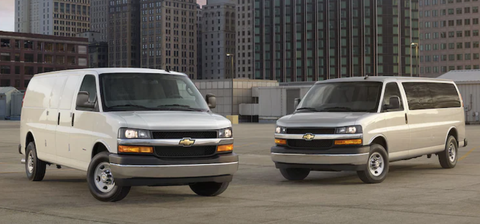The Chevy Express Is Still Keeping Ancient Truck Parts Alive
The Chevrolet Express is a workhorse van that’s been around since the mid-Nineties. Available in cargo and passenger configurations, it can be found everywhere from school parking lots to construction yards. While it has received modernizing upgrades over time, the general nature of the van has not changed since 2003, when the Express had its last major update. As the current generation approaches its 20th model year, the Express might just be the oldest new vehicle currently on sale.
General Motors debuted the Chevy Express and its twin, the GMC Savana, in 1996. The first-generation vans were based on an all-new platform dubbed GMT600, derived from GM’s fourth-generation C/K pickup truck. The body-on-frame vans employed a full ladder frame, with the front section of the frame boxed for extra strength. The platform was re-named GMT610 after the 2003 update, which brought substantial improvements including a stiffer three-piece boxed-frame design.
While that 2003 update was pretty extensive, we haven’t seen many changes to the Express since then, and some older components made it through that update unchanged. The platform’s roots in Eighties C/K truck designs can be seen in today’s Express—for example, replacement front shock absorbers like the Monroe 32362 are interchangeable with GM trucks as far back as the 1988 C2500.
The brake components are a bit newer. We can find the front brake calipers on the current Express van being used all the way back in 1999 on the Silverado and Sierra 2500. Those brake calipers also made their way to some other GM products, including the Hummer H2 (2003 to 2009) and the Cadillac DTS (2006-2011). The front brake rotors and hub assemblies also originated in those 2500-series trucks from 1999. The rear parking brake shoes are a bit newer, first seen on vehicles like the 2009 Silverado 3500.
We see the same themes in the Express van’s suspension. The 2003-to-present generation clearly took some inspiration from its predecessor, as the front stabilizer bar assembly is interchangeable with what’s found on Chevy Astro vans all the way back to the late Eighties, per the interchange guide from a replacement piece sold by Mevotech.
The story is much the same once we get inside the van. Looking at the Express/Savana interior, it’s obvious these vehicles are built to be utilitarian, with wide swaths of gray plastic, no touchscreens to speak of, and a conventional analog instrument cluster. As you climb into the driver’s seat, you’re likely to see a DOOR AJAR light on the dashboard, triggered by a sensor in the door jamb that first saw use in the 1995 Pontiac Sunfire. Peek under the steering column, and you’ll find an adjustment lever that’s appeared in everything from the late-Nineties GMC Sonoma to the Saab 9-7X. Surprisingly, while the steering wheel looks similar to what was found in nearly every GM truck and SUV during the turn of the 21st Century, it’s actually unique to the Savana and Express.
From the perspective of power window switches, the Express is a coupe, so GM dug around in the parts bin and grabbed the driver’s-door switch panel from the 2006-2007 Chevy Monte Carlo. The headlight switch harkens back to the same era, first seen on the 2007 lineup of GM trucks and SUVs where it popped up on everything from the H2 to the Avalanche.
The powertrain options are a little more recent. Order up a brand-new 2022 Chevy or GMC work van, and you can choose the 2.8-liter Duramax turbodiesel four-cylinder engine found in the Chevy Colorado and GMC Canyon. If you prefer gasoline power, your choices are GM’s 4.3-liter V-6 or a 6.6-liter V-8—basically, a punched-out version of the 6.2-liter L86 that started its life in the 2014 Silverado and Sierra.
The Express and Savana have stayed familiar throughout the years. There’s good reason for that, and for why the last major redesign occurred when George W. Bush was president. Sticking with the same basic design for all these years has made life easier for the people who use these vans: If your first stop after leaving the dealership is to install racks, shelves, or accessibility equipment, you want to be sure everything will fit without fuss. In a vehicle like this, sticking with familiar and widely-available parts is a virtue.
This content is created and maintained by a third party, and imported onto this page to help users provide their email addresses. You may be able to find more information about this and similar content at piano.io




